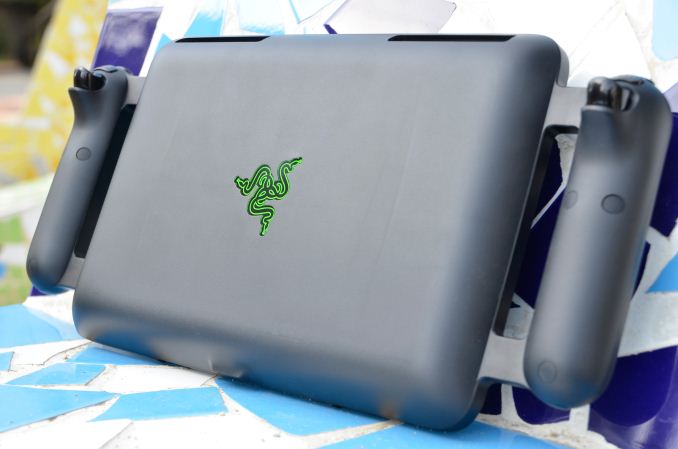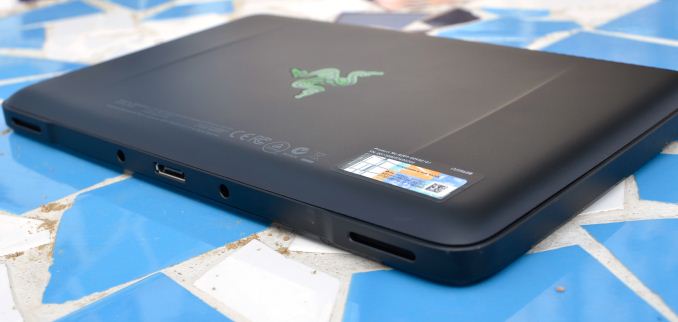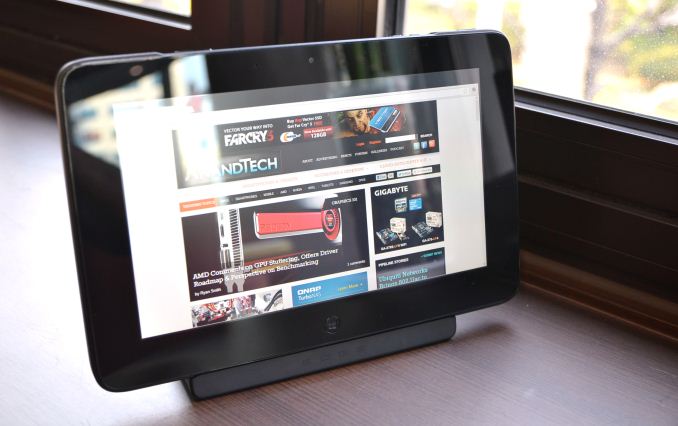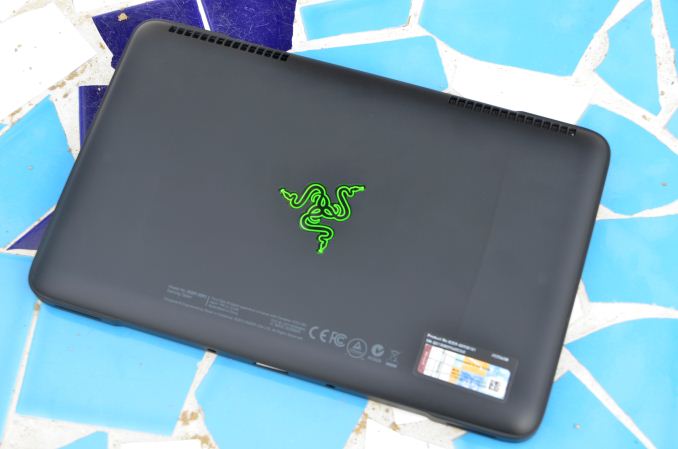The Razer Edge Review
by Vivek Gowri on March 28, 2013 11:00 AM EST- Posted in
- Tablets
- Mobile
- Razer
- Razer Edge
Design
The Edge will be pretty familiar to anyone who has seen or spent any time with Razer systems in the past – consider a tablet with the same design language as the Blade and you’ll be on the right track. Like the Blade that came before it, the design is clean and understated. The matte black anodized aluminum chassis looks actually like a shrunken version of the Blade lid, with the same vertical ridges flanking a glowing green Razer logo. The edges are all radiused, with two large vents on the right and left sides of the top edge (intake on the left, exhaust on the right). The sides of the tablet are unadorned, while the bottom has the dock/power connector located in the center and a pair of speakers located at the corners. The top edge of the tablet has buttons for power, keyboard, rotation, and volume, as well as a 3.5mm combo jack and a USB 3.0 port accented in the traditional Razer green. The front face is completely clean other than the webcam at the top and the circular Windows button located just under the display.
When you first pick it up, it seems pretty antithetical to the slim ARM-based tablets that we’ve gotten used to over the last few years. Even Intel-based tablets like Surface Pro have tried really hard to reach that level of thinness, but the Edge practically flaunts its chunky design. The thickness isn’t the problem I thought it would be going into the review, because quite honestly, the size doesn’t make it uncomfortable to use. The curved sides make for a good in-hand feel, and the Edge feels more comfortable than Surface Pro does. My biggest issue with Surface Pro is that it felt really heavy, but because the Edge weighs just as much and has a significantly larger chassis, it doesn’t have that same dense feel to it. The ridges on the back also play into the in-hand feel, the subtle curvature acts almost like a grip that helps you hold the tablet. It just has a nice, solid, reassuring feel to it when you pick it up.
Razer made a big deal out of the speakers when I last saw the Edge at CES. Tablet audio has been overlooked for the last few years, though it’s finally starting to get its share of attention. The Edge has enough room in the chassis to pack a pair of surprisingly good stereo speakers. Any time you get solid midrange and any semblance of bass out of a tablet or ultrabook, you should be thrilled – it doesn’t happen very often. The speakers on the Edge are clearly and distinctly louder and more defined than any tablet or ultrabook I’ve spent time with in recent times – iPad (even the mini, which has stereo speakers), Surface Pro, ATIV Smart PC and Smart PC Pro, Zenbook Prime, Aspire S7, you name it. They’re legitimately better than any other prominent device in this class.
I have a couple of nits to pick with the design. The first is the bezel around the display – it’s huge. Tablets tend to have larger bezels than we like on notebooks, and the display edge gestures in Windows 8 also have a role to play here, but there’s something to be said for the elegance of a slim bezel. The Edge has a bezel that’s just over an inch wide all the way around. That’s pretty substantial, even compared to the healthy 0.75” width of the iPad’s bezel. The generous bezel means that you’re never worried about accidentally touching the display, but I’d like to see a display closer in size to Surface’s 10.6” panel in this same size chassis. I’m not sure how feasible it is for a company like Razer to get a somewhat irregularly sized panel, though. I’d also be interested in seeing how much bigger the chassis would need to be to fit an 11.6” display, and I’m sure John Wilson and his team kicked that idea around before settling on the 10.1” panel. It’s clear that the ideal display size for Windows tablets is somewhere between 10.1” and 11.6”, so it’ll be interesting to see if more manufacturers take Microsoft’s lead and start shipping devices later this year with displays in the 10.6”-11.1” range.
The other is the Windows sticker on the back – I think they’d have been better off integrating that into the power brick the way ASUS has been doing with their design-oriented systems for some time now. Perhaps I was spoiled by the sleekness of the Blade’s 120W brick, but in comparison the off-the-shelf Chicony 65W AC adapter is ugly and looks like a cheap touch on an otherwise very polished product. I’d like to see something slimmer, like a downsized version of the Blade adapter, with the product stickers integrated to really complete the clean aesthetic the rest of the device has.














89 Comments
View All Comments
jeffkro - Friday, March 29, 2013 - link
I heard an interview with a game developer who started in PC gaming, forget which one. He said they pushed for the switch from PC to consules, tragic. Now he said their push is going to be from consules to mobile devices, even worse. These are sad days for PC gamers, and each step down to lower end hardware has cut the potential of gaming.perry1mm - Saturday, March 30, 2013 - link
I think a lot of people miss the point and just overlook the potential uses this offers for people that might travel a few weeks or even months out of the year and are on the go a lot.For work I spend a couple weeks in a hotel a year, travel to see family a week or two, and spend a few weekends away here or there, not to mention just driving around or spending time out and about sitting down someplace for an hour or two.
There is no way I'd haul around my gaming desktop, this is great for on the couch average use, docking on-the-go, and gaming when plugged while traveling.
BUT, I ended up getting the Sony Vaio Duo 11 two months ago and it does all of this stuff, has a backlit keyboard attached already, I got the extended battery on sale, and total I paid $1450 for mine with a promo + $100 credit since I got the Sony Card, plus 8500 points ($85 more dollars of Sony Rewards). So out-the-door around $1300 with the newer i7 3537u, 8GB RAM, 256GB SSD, and the HD 4000 has played 90% of the games at full resolution (1080p).
Not to mention the HDMI built in, VGA out, SD slot, 2 USB 3.0 slots, and numerous other features that make it much more handy in a laptop functionality (gaming) a lot with still being portable for touch use in tablet mode.
For the people that rip on these products as being overpriced...no. When an ARM tablet can cost $500-800 and an ultrabook $1000+, paying $200-500 more for this with the hardware you're getting, storage/SSD, and accessibility, it is NOT really that expensive.
Now if all you do is sit at home and play games for a few minutes on your phone when on-the-go, or you don't care about space and lugging around a large laptop...then maybe this isn't for you. But both the Edge and Vaio Duo for me were great fits, I just happened to be perfectly happy with the Duo as to not need the Edge.
Netscorer - Saturday, March 30, 2013 - link
Weight and battery life are killers for this product. Price is an issue but there are people willing to pay for the mobility and they would not mind paying extra for exclusivity too. But once you consider that you always (ALWAYS!) need to brace this tablet against something (be it a lap on a train or table at the coffee shop) and that even then you can get at most 2 hours on a freshly charged batteries, the appeal of this hybrid goes way down and frankly, you can do the same on a laptop with a good trackpad, costing much less and having more versatility in other functions. By the way, I was surprised that Vivek never mentioned how absence of the physical keyboard affected using this device. Microsoft did a piss poor job with the virtual keyboard that blocks 2/3 of the screen every time you bring it up and when something like this happens as you prepare to game, it would be a major nuisance.MobiusStrip - Monday, April 1, 2013 - link
Look at that idiotic glossy screen.Death666Angel - Monday, April 1, 2013 - link
It's definitely an interesting product. I don't need a portable gaming machine, so this isn't for me. But even if it were: no display output and the display resolution kill it for me. You may justify the resolution, but it is still not acceptable for me. I'd rather have smaller pixels so that non-native resolutions look better as well. This is a compromise I'm not willing to put up with (and yes, I know that higher resolution would also mean more power draw from the display at same brightness). Also, 11.6" would have been a better display size in my opinion, could have upped the battery package or reduced the thickness. And I personally still don't play FPS games with a gamepad (or many other types for that matter) so for many games I'd need the dock and a keyboard/mouse. All in all, I think I'm better off with sticking with my Ativ Pro for the few games I want to play when I'm on holidays. :DAs for the review: Well done. But I'd really like a comment on whether or not this tablet supports Optimus and the corresponding battery life. :)
IceStorm - Tuesday, April 2, 2013 - link
As an Edge Pro owner, I agree with what has been written in the review. I've been busy installing and playing games since it arrived yesterday. It is fun.I have tried the Surface Pro. The lower resolution of the Edge is not an issue. If anything, it makes it easier to select things when at the traditional desktop. The screen is quite nice, and I have a retina iPad and a Kindle Fire HD for comparison.
This is an early adopter product. It is not for everyone. Just like the first Blade, if you balk at the price it isn't for you. The Razer store sold out of the initial production run of the 256GB Edge Pro in less than five hours. There is a market for it.
seapeople - Sunday, April 7, 2013 - link
I can picture the scene now outside the Razer store. A bunch of happy gamers walking out to their Corolla's, stumbling over the curb as they are locked into an intense game of Half Life, while dozens of well dressed men in suits shake there head and sneer as they lament how much money these gamers are wasting on this platform. The men in suits then jump into their Ferrari 328 GTS's and cruise off into the sunset, waiting in tempered melancholy for the day when they, too, will have the means to afford a handheld gaming unit that will bring joy to their lives.0 adrian 0 - Wednesday, April 3, 2013 - link
.MajinBlayze - Tuesday, December 3, 2013 - link
In your review regarding the downgrade from the pro version:"You lose the 1080p display and Wacom digitizer"
according to the support page here: http://www.razersupport.com/gaming-systems/razer-e... "The Razer Edge is not Wacom or pressure sensitive compatible"